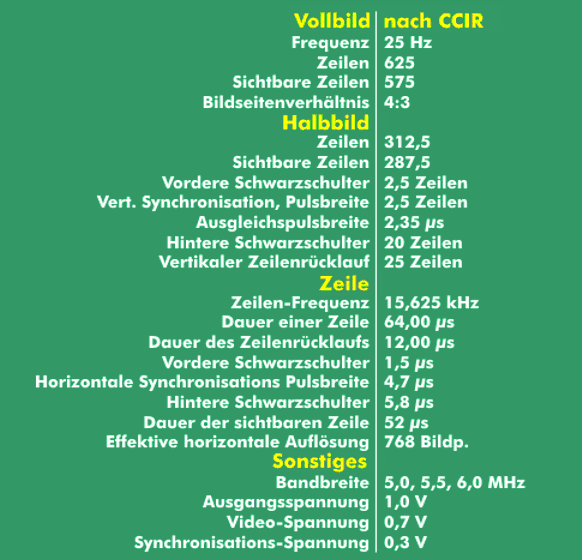television (TV)
Television (TV) is moving image transmission with sound from one transmitter to many receivers, i.e. in broadcast. The transmission is unidirectional and has no return channel, at least not in analog television. The image transmission oftelevision can be in black and white or color and can be transmitted via terrestrial networks, satellites or as cable television( DVB-C, CATV) via cable distribution networks. In addition to analog television, there is digital TV, known as Digital VideoBroadcasting (DVB).
Analog television
In analog television, the luminance signal for brightness and the two color difference signals "U" and "V" are obtained from the component video. The blanking (A) and synchronization (S) signals are added to the luminance signal before modulation. The resulting BAS signal is transmitted in amplitude modulation for all television standards, suppressing the carrier signal and transmitting a sideband with reduced bandwidth. The modulation of the chrominance signals is different for SECAM and the PAL television standard; while SECAM transmits the color signals with frequency modulation, the PAL television standard and NTSC operate with amplitude modulation. In this case, the modulation of the color difference signals takes place within the spectral range of the brightness signal. The sound signal, on the other hand, is transmitted outside the spectral range of the brightness signal; for this purpose, the sound signal is modulated onto a sound carrier using frequency modulation.
The different modulation methods ensure the compatibility of black and white and color transmissions, so that a color television can also display black and white representations and a black and white television can also display color representations, albeit in black and white. In addition, the possibility of crosstalk from sound signals to the picture signal had to be taken into account when defining the standards.
In terms of reception, the FBAS signal is obtained from the luminance signal, the chrominance signal, the blanking signal and the synchronization signal, which is split into the three primary colorsred (R), green (G) and blue (B) for the control of color screens.
Frequency ranges of analog television
Analog television uses frequencies in the VHF and UHF bands for terrestrial transmission, namely in the VHF band, band I between 48.25 MHz and 62.25 MHz for channels 2, 3 and 4, and band III between 175.25 MHz and 224.25 MHz for channels 5 to 12. In UHF, bands IV and V from 471.25 MHz to 599.25 MHz and from 607.25 MHz to 855.25 MHz. In band IV, the 16 channels are 21 to 37, and in band V, another 31 channels from channel 38 to 90. While the TV channels in band I and band III have a bandwidth of 7 MHz, in bands IV/V, this is 8 MHz.
For transmission in cable distribution networks, three special channel ranges are available in addition to the channels used in terrestrial: the lower special channel range( USB) between 112.25 MHz and 169.25 MHz for 9 television channels at 7 MHz, the upper special channel range(OSB) between 231.25 MHz and 294.25 MHz, also with nine channels, and the extended special channel range( ESB) with 20 8 MHz channels between 303.25 MHz and 463.25 MHz.


